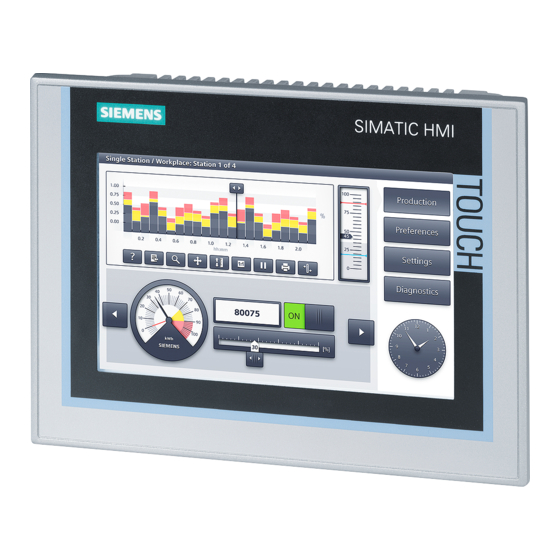Table of Contents
Advertisement
SIMATIC HMI
HMI devices
Comfort Panels
Operating Instructions
07/2017
A5E36770603-AB
___________________
Preface
___________________
Overview
___________________
Safety instructions
___________________
Mounting and connecting the
HMI device
___________________
Commissioning the device
___________________
Commissioning a project
___________________
Operating a project
___________________
Maintenance and care
___________________
Technical information
___________________
Technical Support
___________________
Markings and symbols
___________________
Abbreviations
1
2
3
4
5
6
7
8
A
B
C
Advertisement
Table of Contents

Summarization of Contents
Overview
1.1 Product Description
Summarizes the HMI device line, models, and core features.
1.2 Scope of Delivery
Lists the components included with the HMI device.
1.3 Device Configuration
Details the physical layout and interfaces of different HMI models.
1.4 Accessories
Lists optional and included accessories for HMI devices.
1.5 HMI Device in Operating Process
Explains the role of HMI in configuration and process management.
1.6 Software Add-ons
Describes available software extensions for HMI functionality.
Safety Instructions
2.1 General Safety Instructions
Covers essential safety precautions and directives for HMI operation.
2.2 Security Management for HMI Devices
Discusses measures for protecting HMI devices from unauthorized access.
2.3 Notes About Usage
Provides critical information on proper operating conditions and limitations.
Mounting and Connecting the HMI Device
3.1 Preparing for Installation
Details steps like checking contents, conditions, and selecting mounting positions.
3.2 Mounting the Device
Explains the procedure for physically installing the HMI device using mounting clips.
3.3 Connecting the Device
Guides on connecting power, configuration PC, controllers, and other peripherals.
Commissioning the Device
4.1 Overview
Introduces firmware, software, and memory concepts for HMI devices.
4.2 Operating the Device
Explains how to operate the device using system keys and general functions.
4.3 Parameter Assignment for Comfort Panel
Covers configuration of desktop, security, network, and system settings.
Commissioning a Project
5.1 Overview
Introduces project phases and the transfer process to HMI devices.
5.2 Operating Modes
Describes offline, online, and transfer modes for HMI device operation.
5.3 Using Existing Projects
Guides on migrating and using existing WinCC projects.
5.4 Data Transmission Options
Details data transfer capabilities via different channels.
5.5 Transferring a Project with WinCC
Explains how to configure channels and start project transfer.
5.6 Backup and Restore
Covers procedures for backing up and restoring HMI device data.
5.7 Updating the Operating System
Guides on updating the HMI device's OS and resetting to factory settings.
5.8 Managing Add-ons and License Keys
Explains installation of software add-ons and management of license keys.
Operating a Project
6.1 Overview
Describes operator input options like touch screen, keyboard, and mouse.
6.2 Function Keys
Explains global and local assignment of function keys on key HMI devices.
6.3 Direct Keys
Details the use of direct keys for I/O bit manipulation and short reaction times.
6.4 Setting the Project Language
Covers how to change the HMI's display language at runtime.
6.5 Input of Values
Explains how to enter and modify values in I/O fields using system or screen keyboards.
6.6 Entering and Editing Numerical Values
Guides on inputting numerical data, including date, time, and hexadecimal values.
6.7 Entering or Changing Alphanumeric Values
Describes inputting alphanumeric data via system or screen keyboards.
6.8 Displaying Infotext
Explains how to access additional information configured for screen objects.
6.9 Closing the Project
Details the procedure for closing the active project on the HMI device.
Maintenance and Care
7.1 Maintaining Touch Screen and Keyboard Cover
Provides instructions for cleaning and maintaining the HMI's touch screen and keyboard.
7.2 Cleaning Touch Screen
Explains the process for cleaning the touch screen while the HMI is operational.
7.3 Spare Parts and Repairs
Information on obtaining spare parts and the procedure for device repairs.
7.4 Recycling and Disposal
Guidelines for environmentally sound disposal of HMI devices.
Technical Information
8.1 Software License Agreements
Outlines terms for Microsoft and Open Source software licenses.
8.2 Certificates and Approvals
Lists EU directives, UL, FM, and Ex approvals for the HMI device.
8.3 Electromagnetic Compatibility
Covers EMC compliance and installation guidelines for interference-free operation.
8.4 Mechanical Ambient Conditions
Specifies conditions for storage and operation related to mechanical stress.
8.5 Climatic Ambient Conditions
Details environmental conditions for storage, transport, and operation (temperature, humidity).
8.6 Insulation Tests, Protection Class, Degree of Protection
Provides details on electrical safety, protection ratings (IP), and insulation standards.
8.7 Dimension Drawings
Displays detailed physical dimensions for various HMI models.
8.8 Technical Specifications
Provides comprehensive technical data on weight, display, input, memory, interfaces, and power.
8.9 Bit Assignment of Direct Keys
Shows the mapping of keys and LEDs to controller I/O bytes for direct key functionality.
8.10 Description of the Ports
Details the pin assignments and specifications for all physical ports on the HMI device.
8.11 Communication with Controllers
Lists compatible controllers and communication drivers for HMI integration.
8.12 Scope of Functions with WinCC
Outlines the capabilities and limits of WinCC features (alarms, tags, screens, recipes).
Technical Support
A.1 Service and Support
Provides resources for obtaining information, support, and documentation online.
A.2 Troubleshooting
Offers guidance on identifying and resolving common error messages and faults.
A.3 System Events
Explains how system events provide information about internal HMI and controller states.
Markings and Symbols
B.1 Safety-Relevant Symbols
Explains various safety symbols used on the device and its packaging.
Abbreviations
C.1 Abbreviations
Lists common abbreviations used throughout the manual.














Need help?
Do you have a question about the SIMATIC HMI KP700 Comfort and is the answer not in the manual?
Questions and answers